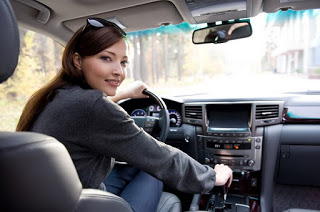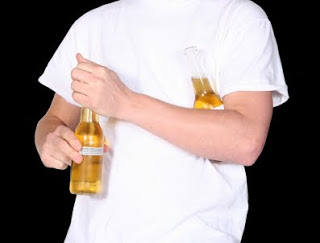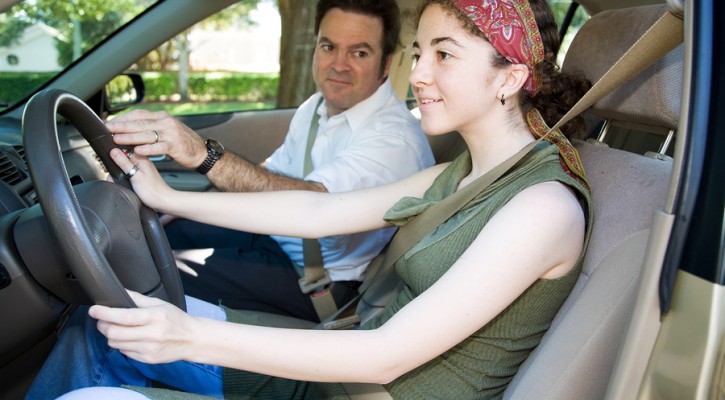Tag Archive: Parents

Effectiveness Of In-Vehicle Monitoring Systems For Teen Drivers
November 9, 2011
The Insurance Institute for Highway Safety (IIHS) conducted an interesting experiment in 2009 that tested the effectiveness of various in-vehicle monitoring systems on teen drivers. The study monitored the driving habits of 84 teen drivers with different types of in-vehicle technology to determine which ones had the greatest effect on both the teen drivers and their parents.
IIHS installed their own monitoring equipment in the study vehicles that recorded when drivers braked sharply or accelerated suddenly, didn’t use belts, and exceeded speed limits. The monitors used GPS and a satellite modem to transmit the data to a central processing facility and the data was made available for parents to review. In addition to its own monitoring systems, IIHS also installed different types of in-vehicle monitoring that are commercially available to parents of teen drivers. The 84 subjects were randomly assigned into four groups:
“Drivers in groups 1 and 2 heard audible alerts for risky maneuvers. A short, low-pitched buzz sounded for sudden braking and acceleration. A continuous low-pitched buzz sounded when the belt wasn’t buckled and stopped only when it was fastened. Speeding triggered a single beep at 2.5 mph over the posted limit, followed by continuous beeps at increasing pitch and frequency when the teenage drivers exceeded the limit by more than 10 mph.” For drivers in group 1, the information was immediately recorded and transmitted to the parents for review. The drivers in group 2 had the opportunity to correct their behavior and, if corrected within 20 seconds, prevent a report from being sent to their parents.
There were no in-vehicle alerts for drivers in group 3, just website notification. Group 4, the control group, was monitored but had no alerts or web notification.
The different types of monitoring systems included:
- Basic systems: CarChip Pro – http://www.carchip.com/Products/8226.asp, CarChipPro is essentially a black box that plugs into the car’s diagnostic recorder. The system can record speed, mileage, and other data. Once the information is downloaded, it provides parents with a history of the teen’s driving. The system may also be set to turn into an alarm if certain speeds are reached or if the driver is braking too hard. The system is a tool to help discuss a teen’s driving habits by allowing parents to show them the facts, and how to correct their driving behavior.
- GPS-based systems: Inthinc’s Tiwi – http://www.inthinc.com/products/tiwifamily This system monitors drivers in real-time by providing in-vehicle, verbal feedback to the driver when they are speeding, not wearing their seat belt or driving aggressively. Also, parents can be notified immediately of unsafe driving behavior (through text, voicemail or email) and all info is reported through an Internet-based portal for later review and discussion between parent and teen. This system gives teens a chance to correct their behavior before their parents are notified.
- Video systems: DriveCam: Teen Safe Driver Program package – http://www.drivecam.com/, This in-car camera system records “risky driving behavior” and sends them to DriveCam for third-party assessment of a teen driver’s skills. The reports are then sent to parents, who can discuss the driving behavior with their teen.
- Smart keys: MyKey – http://media.ford.com/article_display.cfm?article_id=29172, First seen on the 2010 Ford Focus, the MyKey system is designed to help parents set certain limitations on their Ford vehicles for when their teens are driving. With the configurable key, this system is designed for parents who share their cars with teen drivers. Ford has announced that this technology will be available in all Ford vehicles beginning in 2012. The key features are:
- Do Not Disturb, prevents use of cell phone and texting while the car is in motion.
- Speed Control, limiting the top speed of the Ford vehicle to 80 mph.
- Volume control, which allows parents to set a maximum volume level for the car’s radio.
- Beltminder, an alarm system that mutes the radio and plays a chime every 6 seconds, every minute or every 5 minutes when the seatbelt is unbuckled.
- Fuel reminder: alerts the teen that they need to refuel, when fuel is low.
The results of the study were as follows:
- Seat belts – Seat belt use was already at a 94% level when the study began but increased among all four groups when the drivers were faced with a continuous buzzing or chiming noise. This has been found to be effective among all age groups.
- Stops and starts – Sudden braking and rapid starts can indicate aggressive driving or inattention to the driving environment. Sudden stops and starts fell in all groups relative to the control group but was especially significant group 1 with immediate web notification to their parents. The effects were even greater among those whose parents received periodic report cards.
- Speeding – Speeding was the most prevalent risky behavior noted among all groups. Speeding up to ten mph over the posted speed limit fell among the groups with alerts in their vehicles but then started to rise over time. Speeding was only significantly reduced among the groups whose parents were notified or those who had a chance to correct the problem before parental notification.
- All risky behaviors – Risky behaviors declined most among the two groups with parental notification but were most noticeable among group 2, the ones who had a chance to correct their behavior before parental notification. Risky behavior was somewhat higher in group 1, apparently because it was too late to correct the behavior and their parents were going to be notified anyway.
Parents will want to consider the results of this study when choosing an in-vehicle monitoring device for their teen driver.

How to Deal with Underage Drinking: Tips for Parents
September 15, 2009
Restricting your teen’s access to alcohol is one of the most important things you can do for them as a parent. There are highly-publicized risks of fatal alcohol poisonings and devastating motor vehicle crashes due to drinking and driving, for example. But there are other, less-publicized risks that could be equally destructive to your teen’s health and well-being, such as increased risk of sexually transmitted diseases and unintended pregnancy, violence and rape, and suicide.
Of course, underage alcohol use has consequences other than legal ramifications:
- Early alcohol use, independent of other risk factors, strongly predicts the development of alcohol dependence. Of all people who ever meet the diagnostic criteria for alcohol dependence in their lifetime, nearly half do so by age 21 and two-thirds by age 25.
- Due to differences between the adult brain and the brain of the maturing adolescent, many young drinkers:
- Are able to consume much larger amounts of alcohol than adults before experiencing the negative consequences of drinking, such as drowsiness, lack of coordination, and withdrawal/hangover effects.
- Are particularly sensitive to the positive effects of drinking, such as feeling more at ease in social situations; young people may drink more than adults because of these positive social experiences (NIAAA, 2009).
- Recent evidence suggests adolescent drinking can inflict permanent damage on the developing brain (National Research Council and Institute of Medicine, 2004).
To help your teen avoid the use of alcohol and its attendant problems, maintain an ongoing, open dialogue about underage drinking and the risks involved. Make sure she understands that underage drinking is never acceptable. The fact that she is at a party or it is a special occasion or that some parents might “look the other way” when their teenage children drink alcohol does not change the fact that underage drinking is illegal and very dangerous. If your teen is attending a party at a friend’s house, make sure her friends’ parents don’t intend to provide alcohol; this is illegal in every state. You might be surprised to discover that other parents plan to provide their teens and their friends with alcohol in a “safe” manner and location. Make sure your teen understands that other adults can’t give her permission to drink alcohol. An alternative is to talk to your teen about organizing a get-together at your own home.
If you and your teen decide to host a party, make a guest list with your teen. Limit the number of teens so you can be sure of adequate chaperonage. Be sure you have contact information on each teen’s parent. Make sure guests and their parents understand that if a teen leaves the party, he won’t be allowed to return and parents will be called. Make sure parents who won’t be chaperoning know the start and end times of the party and will prearrange transportation. Collect all keys so you can keep track of who is arriving and leaving. Keep coats and purses in an area that can be monitored. Speak to each person before he leaves; check for warning signs of impairment. If a guest arrives at the party already under the influence of alcohol or other drugs, keep him there while you call a parent to pick him up. If he leaves and someone is hurt or injured, you could be held responsible.
When your teen spends the night at a friend’s house or goes to a party, call the hosting parent to find out the details. Make sure the hosting parent shares your concerns about the availability of alcohol and that none will be permitted. Ask how much supervision will be provided. Volunteer to chaperone and provide transportation. Let your teen know that you will not approve any outing without sufficient notice so you can speak to the hosting parent first. If your teen will be riding anywhere, at any time, with a friend, make sure it is with someone whose parents do not permit the use of alcohol. Teens are at great risk when riding with other teens, even under the best of circumstances. Talk to your teen about a back-up plan in case something goes wrong.
When your teen is going out for a special event, have her make a record of the planned itinerary for the evening and make sure she agrees to inform you of any changes. Be alert to spontaneous changes in plans on the night of the event; your teen won’t have as much control over the situation if it takes place in an unfamiliar location and/or with people she doesn’t know well. In the excitement of the evening, she could end up in a risky situation before she realizes what is happening.
Create a code with your teen so he can signal for help without attracting the attention of friends. If you don’t know how to text, ask your teen to give you a few lessons; texting is a much easier way for you to communicate than via phone. When you arrive to pick up your teen, he can blame you for having to leave or you can give the excuse of a “family emergency.” Make an agreement that if you do have to pick him up, a discussion about the reason can be tabled until the next morning, when you and your teen are both calm and safe. Otherwise, your teen may avoid calling you for help because he doesn’t want you to know about the circumstances that required the ride home.
And, last but certainly not least, realize that your teen is vulnerable to making poor choices every day. Don’t let your guard down. Finding a balance between being too controlling and allowing too much freedom will require constant effort, but it is a worthwhile endeavor. Your teen’s health and happiness may depend on it.

Alcohol Access and Your Teen – Trust but Verify
March 5, 2009
Your teenage daughter is spending the night at her friend Mary’s house. Mary’s mother seems to be a responsible, law-abiding adult. You’ve met her several times and there is no reason for you to think anything would go wrong. Mary’s dad is involved in charitable organizations. Still, you hesitate – but then think, why not?
The sleepover at Mary’s house seems perfectly innocent. Your daughter and her friend get good grades in school. They haven’t given you any real reason not to trust them. They are good kids. You’ve had the “choices equal consequences” talk with your daughter. And you have to trust your teen sometime, right? You have to let go.
You are trying to be reasonable.
For many parents, this is where the conflict begins. It’s difficult to decide when to hold back and when to let go. But you can’t let your guard down, because teenagers are vulnerable to temptation and peer pressure every day. What happens when…?
Mary’s parents are busy fulfilling their social and community obligations and aren’t paying attention to what your daughter and Mary are doing. They aren’t home, or they have friends visiting, or they are just weary from work, and their guard is down. Or perhaps they wear rose-colored glasses when it comes to Mary and believe that close supervision of the girls isn’t necessary because she would never betray their trust.
The teens head out to a party at John’s house. Maybe they said they were going to the movies, bowling, or just to hang out with John. John’s dad is a “cool” parent. He understands teenagers, likes to have people around and wants to know what goes on with his kids. John’s dad is an involved parent. He is teaching his son to be responsible. He wants John to drink in moderation and to be a responsible drinker. He reasons that John is going to drink alcohol anyway, so why not teach him how to do it responsibly?
So John’s dad buys beer for the party. Not too much, and he sets limits, cautioning John that each teen should have no more than two beers. He stays home to monitor the situation. Everything seems to be going just fine.
But John’s father didn’t consider the following:
- Early alcohol use, independent of other risk factors, strongly predicts the development of alcohol dependence.
- Of all people who ever meet the diagnostic criteria for alcohol dependence in their lifetime, nearly half do so by age 21 and two-thirds by age 25.
- People who reported starting to drink before the age of 15 were four times more likely to also report meeting the criteria for alcohol dependence at some point in their lives (National Institute on Alcohol Abuse and Alcoholism, 2009).
- Compared to youth who wait until they are 21, youth who drink before age 15 are 12 times more likely to be unintentionally injured while under the influence of alcohol, seven times more likely to be in a motor vehicle crash after drinking, and 10 times more likely to get in a physical fight after drinking (National Research Council and Institute of Medicine, 2004).
- Due to differences between the adult brain and the brain of the maturing adolescent, many young drinkers:
- Are able to consume much larger amounts of alcohol than adults before experiencing the negative consequences of drinking, such as drowsiness, lack of coordination, and withdrawal/hangover effects.
- Are particularly sensitive to the positive effects of drinking, such as feeling more at ease in social situations; young people may drink more than adults because of these positive social experiences (NIAAA, 2009).
- Recent evidence suggests adolescent drinking can inflict permanent damage on the developing brain (National Research Council and Institute of Medicine, 2004).These statistics do not take into account the risk that John’s dad is taking; in many states, he can be held criminally liable for providing alcohol to minors on property he owns, leases, or otherwise controls. Civil liability is always an issue; no state makes it legal for an adult to serve alcohol to someone else’s children. But if you aren’t vigilant, a tragedy could occur before you are even aware of the danger your child faces.Strengthen your resolve. Be your teen’s parent, not a friend. Make sure your teen understands that other adults can’t give them permission to drink alcohol. You’ve already said no, and no one else’s parent can overrule you.
Talk to, and listen to, your teen. Maintain an ongoing, open dialogue about underage drinking and the risks involved. Create a code word so that if your teen needs to be picked up early, you’ll do so with no questions asked until the following day, when you are both calm enough to discuss the situation sensibly. Let your teen know that you will not approve any outing without sufficient notice so you can speak to the hosting parent first.
When your teen spends the night at a friend’s house or goes to a party, call the hosting parent to find out the details. Volunteer to chaperone and provide transportation. Make sure the hosting parent shares your concerns about the availability of alcohol and that none will be permitted. Ask how much supervision will be provided.
Limit the amount of time your teen is away from home. Make sure you are awake and alert when the teen returns. Greet your teen with a kiss and a hug so you can observe your child’s physical, mental, and emotional condition.
It’s tempting for parents to relax their vigilance once their children become teenagers. After all, the teens will soon be on their own and beyond their parents’ control. But the teen years are a critical part of your children’s development, and the decisions they make could affect the rest of their lives. This is not the time to let down your guard.

Setting a Good Driving Example for Your Teen
February 20, 2009
Many parents hope that when they teach their teenagers how to drive, their children will do as they say, not as they do, when it comes to driving. But this hope may be unrealistic. Research indicates that children mimic their parents’ driving behaviors from as young as two years of age, so a parent’s bad driving habits may be deeply ingrained by the time training for a driver’s license begins. And teens are notoriously intolerant of what they view as hypocritical advice. When this is combined with over-confidence in their own abilities, your teen could develop bad driving habits early in the training process.
Before you begin teaching your teen to drive, it is a good idea to review and correct any poor driving habits you have developed over the years of driving. Remember that when your teen repeats these behaviors, s/he is doing so without the benefit of your years of driving experience and highly developed driving skills.
A good first step is to review your driving handbook. This will also assist you in knowing what important beginning driver training concepts to reinforce during lessons with your teen. As you review the handbook, make notes on the driving behaviors you need to change. For example, many drivers become lax about using the turn signal every time they change lanes, pull out from a parking space, enter or leave an expressway, or turn at intersections.
Lax driving behaviors are more likely to occur in familiar settings, so pay particular attention to your driving as you travel to and from work and school and on errands. Pretend that these routes are unfamiliar to you. How would you change your driving behavior? Take different routes to and from work, school and errands. Does your driving improve?
Third, begin training early by talking to your teen about your own driving behaviors. As you drive, point out potential hazards as you scan ahead. When you take action, explain what you are doing and why.
Teaching teens to drive should be a process, not an event. It’s important to realize that whether you intend to or not, you are teaching your child to drive every time you get behind the wheel with your child as a passenger.
